Analysis of Childhood Obesity: Causes and Contributing Factors
VerifiedAdded on 2022/08/16
|6
|1011
|13
Report
AI Summary
This report provides an analysis of the causes of childhood obesity, a significant public health challenge. It examines three primary factors: the consumption of fast food and sugary beverages, physical inactivity, and genetic factors. The report highlights how the increasing consumption of fast food, often lacking nutritional value, and sugary drinks contributes to weight gain. It also discusses the impact of physical inactivity, exacerbated by increased screen time and reduced physical education in schools. Furthermore, the report explores the role of genetic factors, including parental obesity, in influencing a child's predisposition to obesity. The report concludes by emphasizing the need for dietary changes, increased physical activity, and interventions from medical organizations to combat the rising rates of childhood obesity and prevent long-term health issues. The report emphasizes the importance of addressing these factors to mitigate the adverse effects of childhood obesity and promote healthier lifestyles for children.
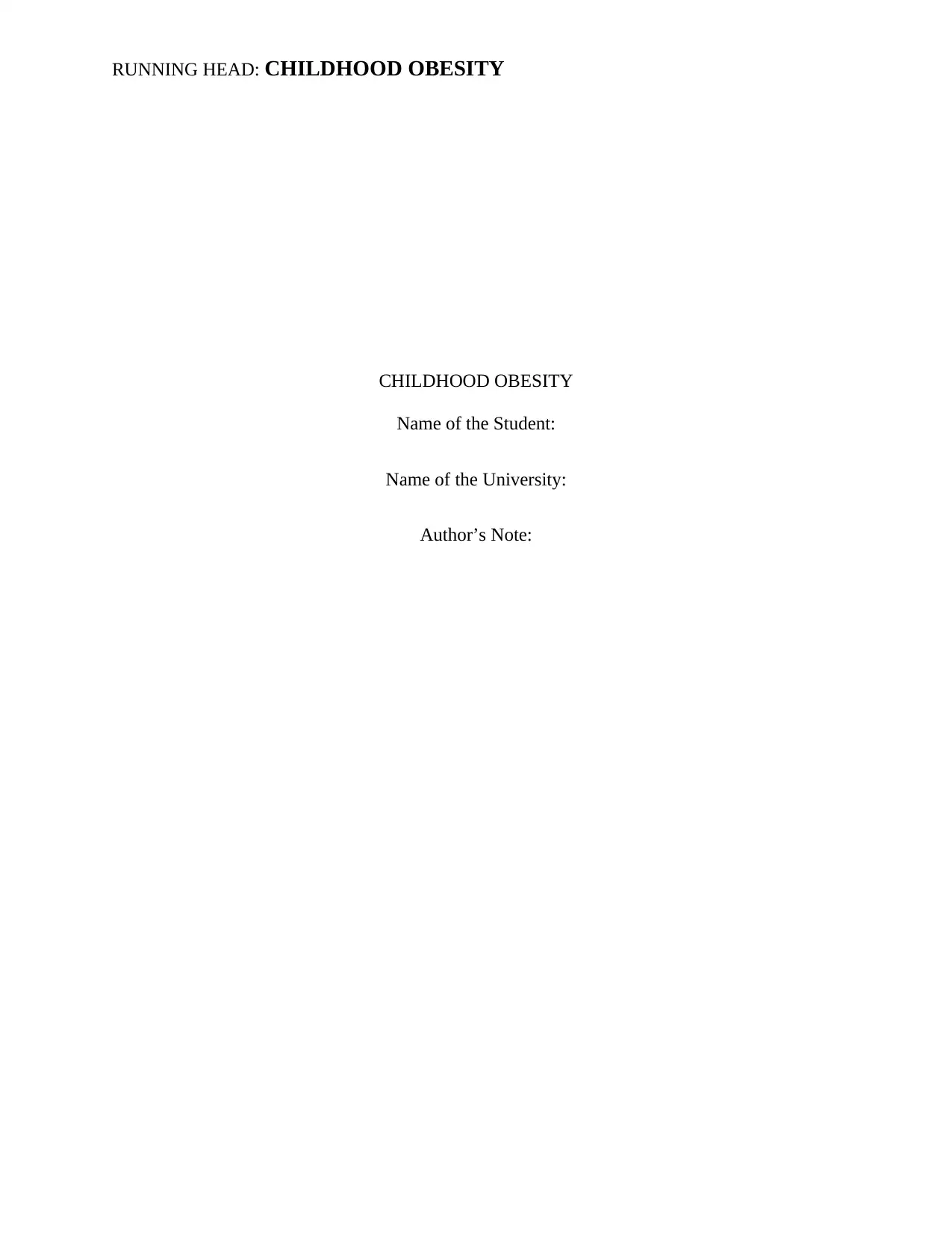
RUNNING HEAD: CHILDHOOD OBESITY
CHILDHOOD OBESITY
Name of the Student:
Name of the University:
Author’s Note:
CHILDHOOD OBESITY
Name of the Student:
Name of the University:
Author’s Note:
Paraphrase This Document
Need a fresh take? Get an instant paraphrase of this document with our AI Paraphraser
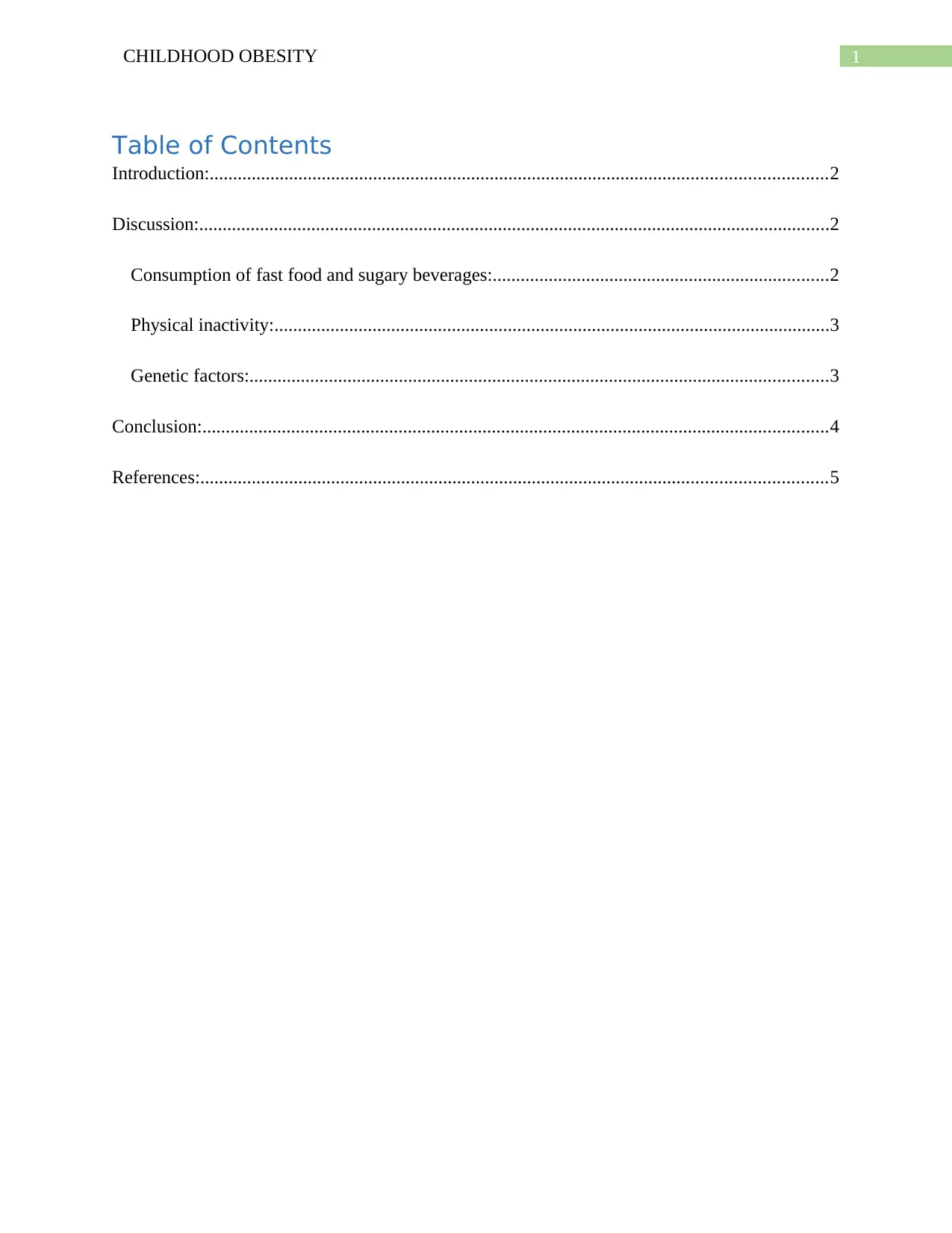
1CHILDHOOD OBESITY
Table of Contents
Introduction:....................................................................................................................................2
Discussion:.......................................................................................................................................2
Consumption of fast food and sugary beverages:........................................................................2
Physical inactivity:.......................................................................................................................3
Genetic factors:............................................................................................................................3
Conclusion:......................................................................................................................................4
References:......................................................................................................................................5
Table of Contents
Introduction:....................................................................................................................................2
Discussion:.......................................................................................................................................2
Consumption of fast food and sugary beverages:........................................................................2
Physical inactivity:.......................................................................................................................3
Genetic factors:............................................................................................................................3
Conclusion:......................................................................................................................................4
References:......................................................................................................................................5
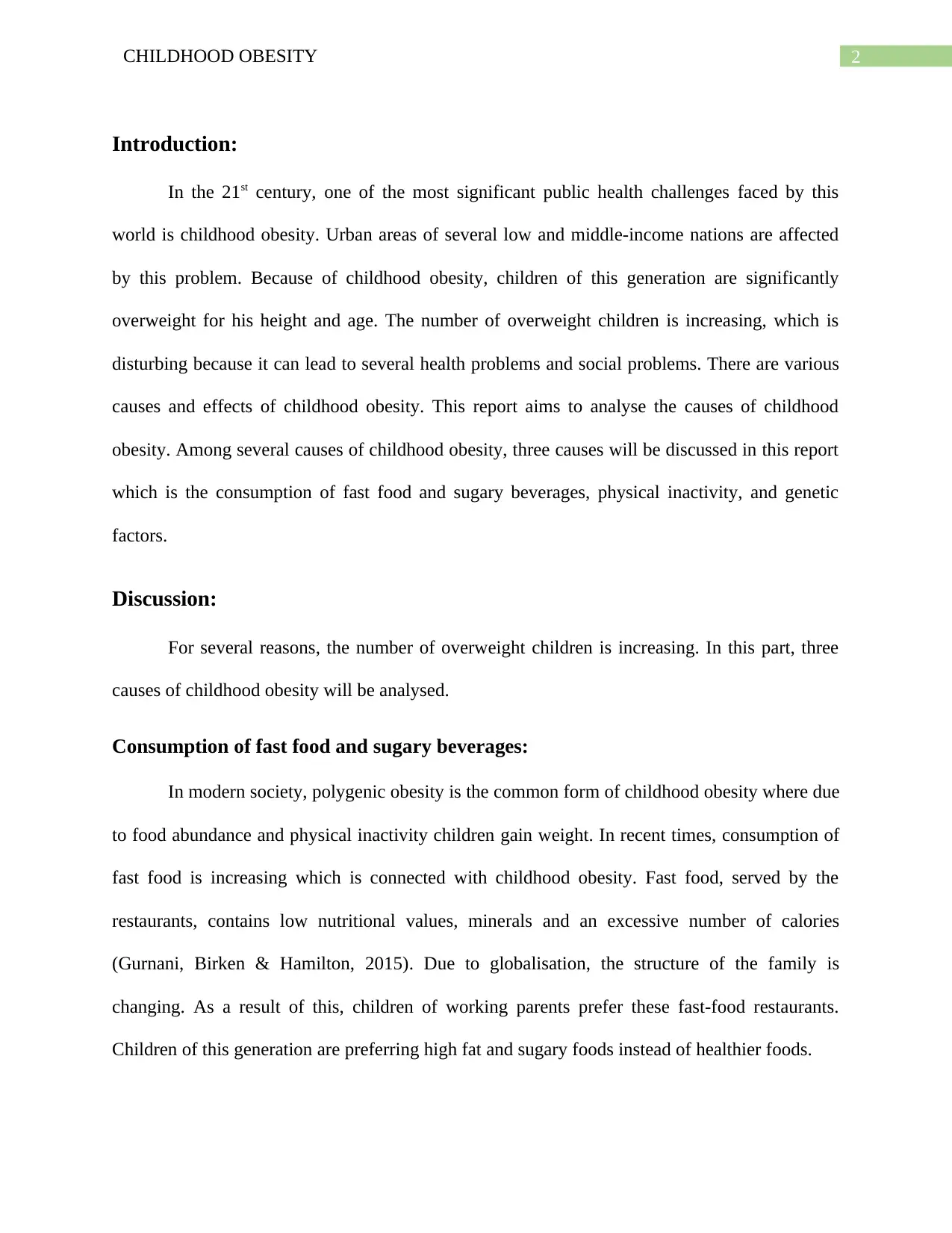
2CHILDHOOD OBESITY
Introduction:
In the 21st century, one of the most significant public health challenges faced by this
world is childhood obesity. Urban areas of several low and middle-income nations are affected
by this problem. Because of childhood obesity, children of this generation are significantly
overweight for his height and age. The number of overweight children is increasing, which is
disturbing because it can lead to several health problems and social problems. There are various
causes and effects of childhood obesity. This report aims to analyse the causes of childhood
obesity. Among several causes of childhood obesity, three causes will be discussed in this report
which is the consumption of fast food and sugary beverages, physical inactivity, and genetic
factors.
Discussion:
For several reasons, the number of overweight children is increasing. In this part, three
causes of childhood obesity will be analysed.
Consumption of fast food and sugary beverages:
In modern society, polygenic obesity is the common form of childhood obesity where due
to food abundance and physical inactivity children gain weight. In recent times, consumption of
fast food is increasing which is connected with childhood obesity. Fast food, served by the
restaurants, contains low nutritional values, minerals and an excessive number of calories
(Gurnani, Birken & Hamilton, 2015). Due to globalisation, the structure of the family is
changing. As a result of this, children of working parents prefer these fast-food restaurants.
Children of this generation are preferring high fat and sugary foods instead of healthier foods.
Introduction:
In the 21st century, one of the most significant public health challenges faced by this
world is childhood obesity. Urban areas of several low and middle-income nations are affected
by this problem. Because of childhood obesity, children of this generation are significantly
overweight for his height and age. The number of overweight children is increasing, which is
disturbing because it can lead to several health problems and social problems. There are various
causes and effects of childhood obesity. This report aims to analyse the causes of childhood
obesity. Among several causes of childhood obesity, three causes will be discussed in this report
which is the consumption of fast food and sugary beverages, physical inactivity, and genetic
factors.
Discussion:
For several reasons, the number of overweight children is increasing. In this part, three
causes of childhood obesity will be analysed.
Consumption of fast food and sugary beverages:
In modern society, polygenic obesity is the common form of childhood obesity where due
to food abundance and physical inactivity children gain weight. In recent times, consumption of
fast food is increasing which is connected with childhood obesity. Fast food, served by the
restaurants, contains low nutritional values, minerals and an excessive number of calories
(Gurnani, Birken & Hamilton, 2015). Due to globalisation, the structure of the family is
changing. As a result of this, children of working parents prefer these fast-food restaurants.
Children of this generation are preferring high fat and sugary foods instead of healthier foods.
⊘ This is a preview!⊘
Do you want full access?
Subscribe today to unlock all pages.

Trusted by 1+ million students worldwide
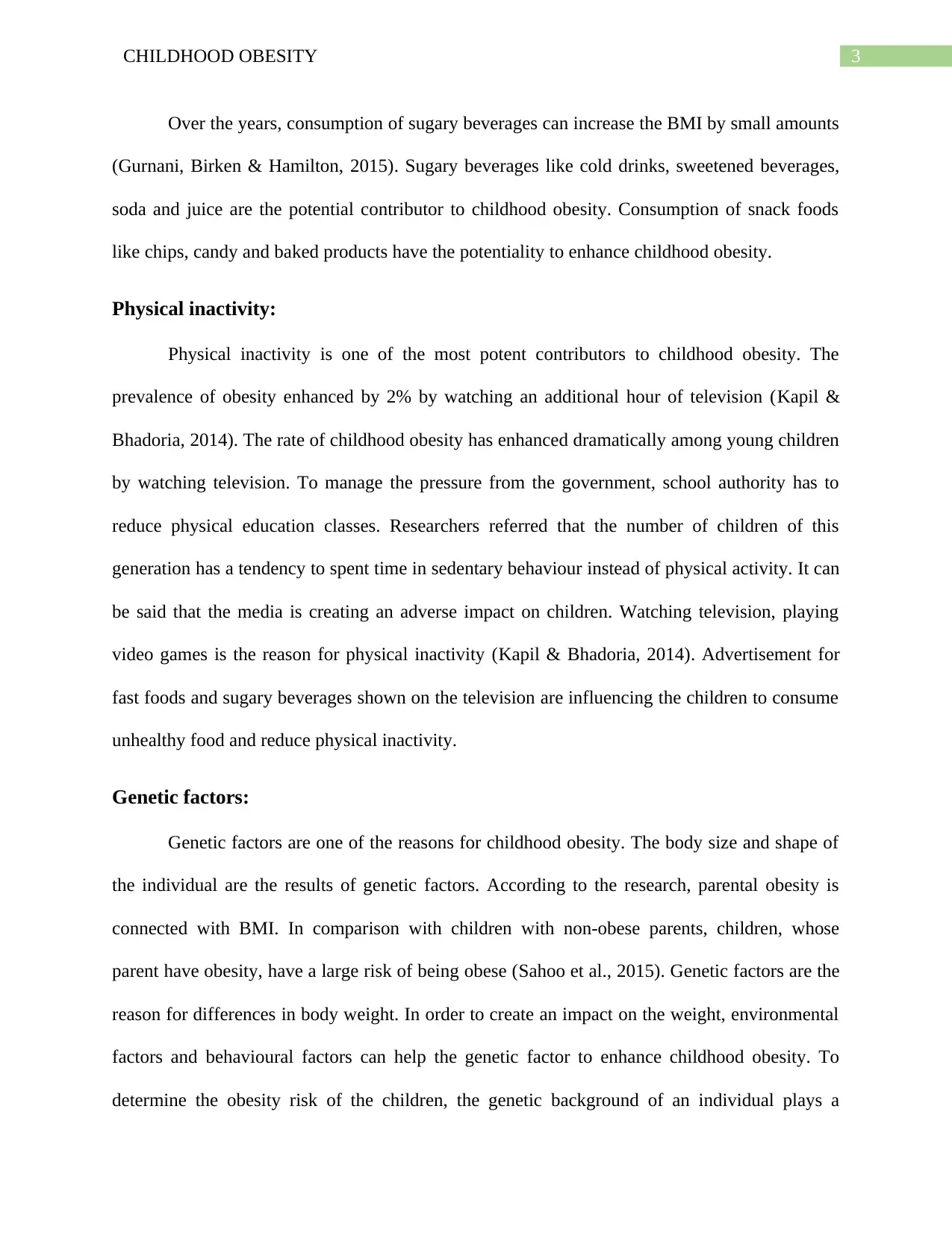
3CHILDHOOD OBESITY
Over the years, consumption of sugary beverages can increase the BMI by small amounts
(Gurnani, Birken & Hamilton, 2015). Sugary beverages like cold drinks, sweetened beverages,
soda and juice are the potential contributor to childhood obesity. Consumption of snack foods
like chips, candy and baked products have the potentiality to enhance childhood obesity.
Physical inactivity:
Physical inactivity is one of the most potent contributors to childhood obesity. The
prevalence of obesity enhanced by 2% by watching an additional hour of television (Kapil &
Bhadoria, 2014). The rate of childhood obesity has enhanced dramatically among young children
by watching television. To manage the pressure from the government, school authority has to
reduce physical education classes. Researchers referred that the number of children of this
generation has a tendency to spent time in sedentary behaviour instead of physical activity. It can
be said that the media is creating an adverse impact on children. Watching television, playing
video games is the reason for physical inactivity (Kapil & Bhadoria, 2014). Advertisement for
fast foods and sugary beverages shown on the television are influencing the children to consume
unhealthy food and reduce physical inactivity.
Genetic factors:
Genetic factors are one of the reasons for childhood obesity. The body size and shape of
the individual are the results of genetic factors. According to the research, parental obesity is
connected with BMI. In comparison with children with non-obese parents, children, whose
parent have obesity, have a large risk of being obese (Sahoo et al., 2015). Genetic factors are the
reason for differences in body weight. In order to create an impact on the weight, environmental
factors and behavioural factors can help the genetic factor to enhance childhood obesity. To
determine the obesity risk of the children, the genetic background of an individual plays a
Over the years, consumption of sugary beverages can increase the BMI by small amounts
(Gurnani, Birken & Hamilton, 2015). Sugary beverages like cold drinks, sweetened beverages,
soda and juice are the potential contributor to childhood obesity. Consumption of snack foods
like chips, candy and baked products have the potentiality to enhance childhood obesity.
Physical inactivity:
Physical inactivity is one of the most potent contributors to childhood obesity. The
prevalence of obesity enhanced by 2% by watching an additional hour of television (Kapil &
Bhadoria, 2014). The rate of childhood obesity has enhanced dramatically among young children
by watching television. To manage the pressure from the government, school authority has to
reduce physical education classes. Researchers referred that the number of children of this
generation has a tendency to spent time in sedentary behaviour instead of physical activity. It can
be said that the media is creating an adverse impact on children. Watching television, playing
video games is the reason for physical inactivity (Kapil & Bhadoria, 2014). Advertisement for
fast foods and sugary beverages shown on the television are influencing the children to consume
unhealthy food and reduce physical inactivity.
Genetic factors:
Genetic factors are one of the reasons for childhood obesity. The body size and shape of
the individual are the results of genetic factors. According to the research, parental obesity is
connected with BMI. In comparison with children with non-obese parents, children, whose
parent have obesity, have a large risk of being obese (Sahoo et al., 2015). Genetic factors are the
reason for differences in body weight. In order to create an impact on the weight, environmental
factors and behavioural factors can help the genetic factor to enhance childhood obesity. To
determine the obesity risk of the children, the genetic background of an individual plays a
Paraphrase This Document
Need a fresh take? Get an instant paraphrase of this document with our AI Paraphraser

4CHILDHOOD OBESITY
significant role (Sahoo et al., 2015) Family characteristics, the lifestyle of the parent, and
parenting style can create an impact on childhood obesity. To prevent childhood obesity, an
increase in physical activities in school can be beneficial for the children.
Conclusion:
This report can be concluded in this way that these three causes are primary reasons for
childhood obesity. Obese children have a tendency to become obese adults. Though childhood
obesity has reached epidemic levels in both the developed and developing countries yet it must
be controlled. Dietary patterns and changing lifestyle must be controlled to manage childhood
obesity. Instead of providing unhealthy fast food, junk food, sugary beverage, and snacks,
parents must control the food habit of the children. The government and the authority of school
must endorse physical activities. Various complex social, environmental and economic factors
are influencing the food behaviour and activity levels of the children. Medical organisations and
physicians have the responsibility to develop a plan to prevent childhood obesity. If the
government do not take proper precautions then children of this generation will have shorter and
unhealthy lives.
significant role (Sahoo et al., 2015) Family characteristics, the lifestyle of the parent, and
parenting style can create an impact on childhood obesity. To prevent childhood obesity, an
increase in physical activities in school can be beneficial for the children.
Conclusion:
This report can be concluded in this way that these three causes are primary reasons for
childhood obesity. Obese children have a tendency to become obese adults. Though childhood
obesity has reached epidemic levels in both the developed and developing countries yet it must
be controlled. Dietary patterns and changing lifestyle must be controlled to manage childhood
obesity. Instead of providing unhealthy fast food, junk food, sugary beverage, and snacks,
parents must control the food habit of the children. The government and the authority of school
must endorse physical activities. Various complex social, environmental and economic factors
are influencing the food behaviour and activity levels of the children. Medical organisations and
physicians have the responsibility to develop a plan to prevent childhood obesity. If the
government do not take proper precautions then children of this generation will have shorter and
unhealthy lives.
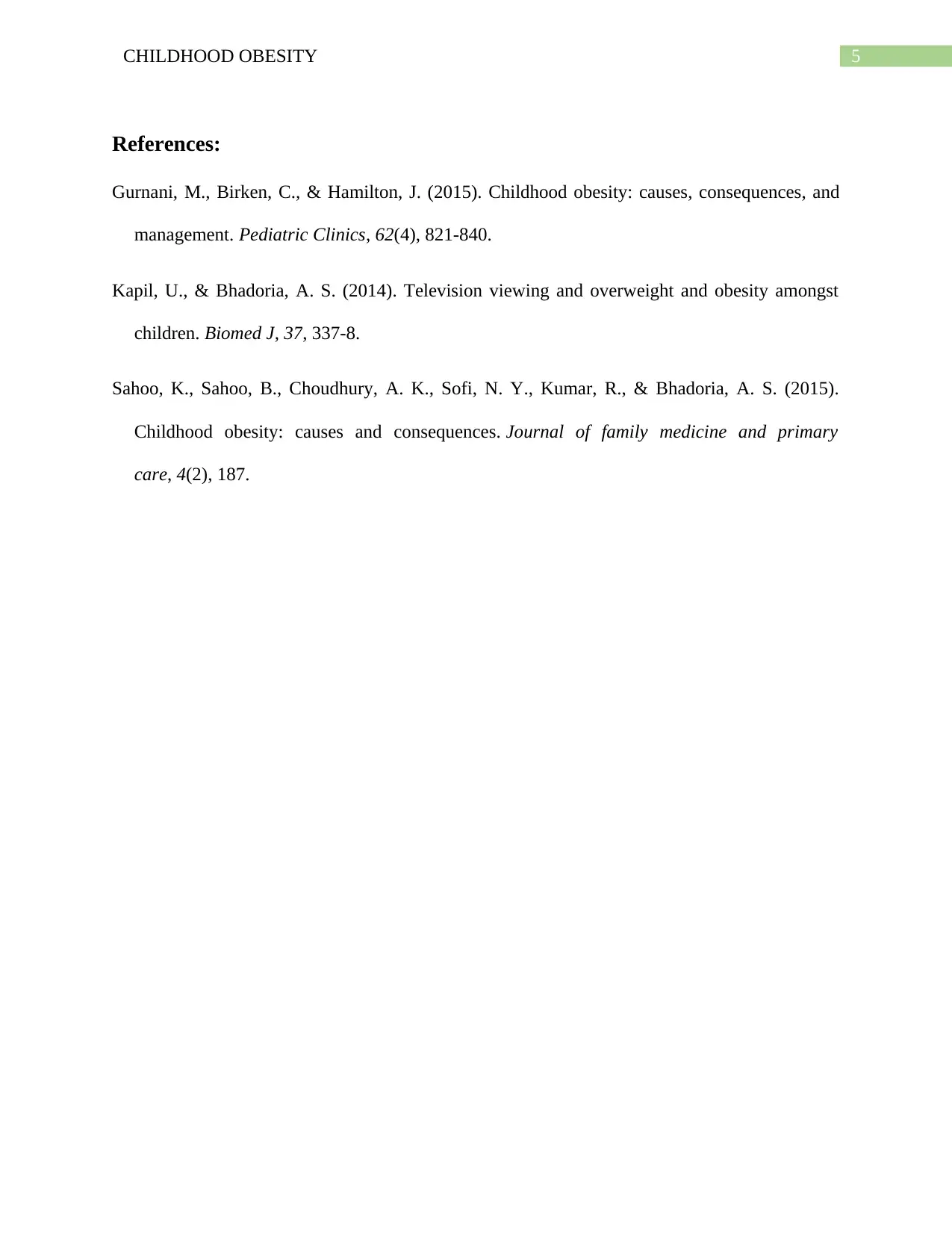
5CHILDHOOD OBESITY
References:
Gurnani, M., Birken, C., & Hamilton, J. (2015). Childhood obesity: causes, consequences, and
management. Pediatric Clinics, 62(4), 821-840.
Kapil, U., & Bhadoria, A. S. (2014). Television viewing and overweight and obesity amongst
children. Biomed J, 37, 337-8.
Sahoo, K., Sahoo, B., Choudhury, A. K., Sofi, N. Y., Kumar, R., & Bhadoria, A. S. (2015).
Childhood obesity: causes and consequences. Journal of family medicine and primary
care, 4(2), 187.
References:
Gurnani, M., Birken, C., & Hamilton, J. (2015). Childhood obesity: causes, consequences, and
management. Pediatric Clinics, 62(4), 821-840.
Kapil, U., & Bhadoria, A. S. (2014). Television viewing and overweight and obesity amongst
children. Biomed J, 37, 337-8.
Sahoo, K., Sahoo, B., Choudhury, A. K., Sofi, N. Y., Kumar, R., & Bhadoria, A. S. (2015).
Childhood obesity: causes and consequences. Journal of family medicine and primary
care, 4(2), 187.
⊘ This is a preview!⊘
Do you want full access?
Subscribe today to unlock all pages.

Trusted by 1+ million students worldwide
1 out of 6
Related Documents
Your All-in-One AI-Powered Toolkit for Academic Success.
+13062052269
info@desklib.com
Available 24*7 on WhatsApp / Email
![[object Object]](/_next/static/media/star-bottom.7253800d.svg)
Unlock your academic potential
Copyright © 2020–2025 A2Z Services. All Rights Reserved. Developed and managed by ZUCOL.




